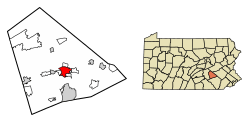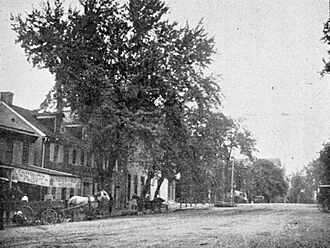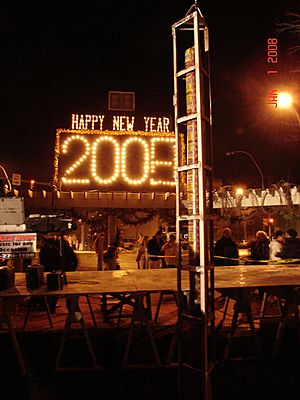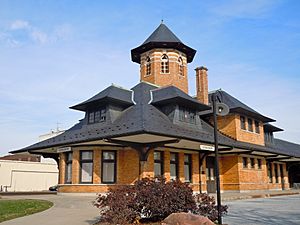Lebanon, Pennsylvania facts for kids
Quick facts for kids
Lebanon
Lebnen (Pennsylvania German)
|
|
|---|---|
|
City
|
|

View down Cumberland Street
|
|

Location of Lebanon in Lebanon County, Pennsylvania (left) and of Lebanon County in Pennsylvania (right)
|
|
| Country | United States |
| State | Pennsylvania |
| County | Lebanon |
| Settled | 1720 |
| Incorporated | 1821 |
| Charter | 1885 |
| Area | |
| • City | 4.17 sq mi (10.79 km2) |
| • Land | 4.17 sq mi (10.79 km2) |
| • Water | 0.00 sq mi (0.00 km2) |
| • Urban | 32.7 sq mi (84.7 km2) |
| Population
(2020)
|
|
| • City | 26,814 |
| • Density | 6,434.85/sq mi (2,484.32/km2) |
| • Urban | 78,147 |
| • Urban density | 2,389/sq mi (3,845/km2) |
| Time zone | UTC−5 (EST) |
| • Summer (DST) | UTC−4 (EDT) |
| ZIP codes |
17042, 17046
|
| Area codes | 717 and 223 |
| FIPS code | 42-42168 |
| GNIS feature ID | 1215365 |
| Website | https://www.lebanonpa.org/ |
Lebanon (pronounced LEB-ən-ən) is a city in Pennsylvania, United States. It is the main city of Lebanon County, Pennsylvania. In 2020, about 26,814 people lived there.
Lebanon was started by George Steitz in 1740. It was first called Steitztown.
The city is located about 61 miles (98 km) southwest of Allentown. It is also 26 miles (42 km) east of Harrisburg. And it's 88 miles (142 km) northwest of Philadelphia.
Contents
History of Lebanon
Long ago, different Native American groups lived in the area that is now Lebanon. These included the Shawnee, Susquehannock, Gawanese, Lenape, and Nanticoke peoples.
European settlers arrived in Lebanon around 1720. Many families, like the Steitz and Light families, settled along a creek. The Light family built a fort called "Light's Fort" to protect themselves. The town was officially planned in 1753. It became a borough in 1821 and a city in 1885.
Lebanon is famous for Lebanon bologna, a type of sausage first made here before the 1780s. The Union Canal, a waterway for boats, ran through the city from 1828 to 1885. San Giorgio pasta has been made in Lebanon since 1914. The city was also once home to a large steel mill run by Bethlehem Steel.
Geography and Climate
According to the U.S. Census Bureau, the city covers about 4.2 square miles (10.9 square kilometers). All of this area is land.
Lebanon is surrounded by several townships. To the north and east is North Lebanon Township. To the south and east is South Lebanon Township. West Lebanon Township is to the west. And North Cornwall Township is to the south and west. The Quittapahilla Creek flows through the city towards the Susquehanna River.
Lebanon's Climate
The weather in Lebanon changes with the seasons. The average temperature in January is about 29.4°F (-1.4°C). In July, the average temperature is around 74.3°F (23.5°C). The area has a hot-summer humid continental climate.
| Climate data for Lebanon, Pennsylvania (1991–2020 normals, extremes 1965–present) | |||||||||||||
|---|---|---|---|---|---|---|---|---|---|---|---|---|---|
| Month | Jan | Feb | Mar | Apr | May | Jun | Jul | Aug | Sep | Oct | Nov | Dec | Year |
| Record high °F (°C) | 70 (21) |
79 (26) |
84 (29) |
91 (33) |
95 (35) |
100 (38) |
103 (39) |
98 (37) |
98 (37) |
90 (32) |
82 (28) |
75 (24) |
103 (39) |
| Mean daily maximum °F (°C) | 37.0 (2.8) |
40.4 (4.7) |
49.4 (9.7) |
62.0 (16.7) |
71.9 (22.2) |
80.0 (26.7) |
84.4 (29.1) |
82.4 (28.0) |
75.6 (24.2) |
64.1 (17.8) |
52.3 (11.3) |
41.7 (5.4) |
61.8 (16.6) |
| Daily mean °F (°C) | 29.5 (−1.4) |
31.9 (−0.1) |
40.1 (4.5) |
51.1 (10.6) |
61.2 (16.2) |
69.9 (21.1) |
74.3 (23.5) |
72.5 (22.5) |
65.5 (18.6) |
54.0 (12.2) |
43.2 (6.2) |
34.3 (1.3) |
52.3 (11.3) |
| Mean daily minimum °F (°C) | 22.0 (−5.6) |
23.4 (−4.8) |
30.7 (−0.7) |
40.3 (4.6) |
50.6 (10.3) |
59.7 (15.4) |
64.2 (17.9) |
62.6 (17.0) |
55.4 (13.0) |
43.9 (6.6) |
34.0 (1.1) |
26.9 (−2.8) |
42.8 (6.0) |
| Record low °F (°C) | −22 (−30) |
−12 (−24) |
−4 (−20) |
18 (−8) |
27 (−3) |
37 (3) |
44 (7) |
38 (3) |
30 (−1) |
18 (−8) |
9 (−13) |
−4 (−20) |
−22 (−30) |
| Average precipitation inches (mm) | 3.06 (78) |
2.55 (65) |
3.60 (91) |
3.72 (94) |
3.99 (101) |
4.49 (114) |
4.85 (123) |
4.63 (118) |
4.63 (118) |
4.10 (104) |
3.21 (82) |
3.57 (91) |
46.40 (1,179) |
| Average snowfall inches (cm) | 6.8 (17) |
7.8 (20) |
4.2 (11) |
0.4 (1.0) |
0.0 (0.0) |
0.0 (0.0) |
0.0 (0.0) |
0.0 (0.0) |
0.0 (0.0) |
0.3 (0.76) |
0.5 (1.3) |
4.0 (10) |
24.0 (61) |
| Average precipitation days (≥ 0.01 in) | 9.9 | 9.0 | 10.5 | 12.0 | 12.6 | 11.4 | 10.7 | 10.1 | 9.5 | 10.0 | 9.2 | 10.4 | 125.3 |
| Average snowy days (≥ 0.1 in) | 3.4 | 3.4 | 1.4 | 0.2 | 0.0 | 0.0 | 0.0 | 0.0 | 0.0 | 0.0 | 0.4 | 1.7 | 10.5 |
| Source: NOAA | |||||||||||||
People of Lebanon
| Historical population | |||
|---|---|---|---|
| Census | Pop. | %± | |
| 1790 | 960 | — | |
| 1800 | 1,439 | 49.9% | |
| 1810 | 1,434 | −0.3% | |
| 1820 | 1,437 | 0.2% | |
| 1830 | 1,826 | 27.1% | |
| 1840 | 1,860 | 1.9% | |
| 1850 | 2,184 | 17.4% | |
| 1860 | 4,449 | 103.7% | |
| 1870 | 6,727 | 51.2% | |
| 1880 | 8,778 | 30.5% | |
| 1890 | 14,664 | 67.1% | |
| 1900 | 17,628 | 20.2% | |
| 1910 | 19,240 | 9.1% | |
| 1920 | 24,643 | 28.1% | |
| 1930 | 25,561 | 3.7% | |
| 1940 | 27,206 | 6.4% | |
| 1950 | 28,156 | 3.5% | |
| 1960 | 30,045 | 6.7% | |
| 1970 | 28,572 | −4.9% | |
| 1980 | 25,711 | −10.0% | |
| 1990 | 24,800 | −3.5% | |
| 2000 | 24,461 | −1.4% | |
| 2010 | 25,477 | 4.2% | |
| 2020 | 26,814 | 5.2% | |
| Sources: | |||
In 2020, about 60.8% of the city's population was White. About 5.4% were Black or African American, and 1.3% were Asian. Also, 5.6% were of two or more races. A large part of the population, 43.8%, had Hispanic or Latino family backgrounds.
Education in Lebanon
The Lebanon School District provides public education for students in Lebanon and West Lebanon Township. The district has five elementary schools, Lebanon Middle School, and Lebanon High School. Starting in the 2024-2025 school year, the middle school will change. It will become an intermediate school for 5th and 6th graders and a junior high school for 7th and 8th graders.
There are also private schools nearby, such as Blue Mountain Christian School, New Covenant Christian School, and Lebanon Christian Academy. These schools offer sports and classes for all age groups. Students in the Lebanon School District can also attend the Lebanon County Career and Technology Center. This center helps students learn job skills. Lebanon is also home to a campus of Harrisburg Area Community College.
Culture and Traditions
Many people believe Lebanon, Pennsylvania, is named after the ancient country of Lebanon in the Middle East. Locals usually say the city's name as "Leb-a-nin." Some even shorten it to "Leb-nin" or "Lep-nin," especially those with Pennsylvania Dutch heritage.
In 1878, a famous trial took place in Lebanon. It involved six people who were called "the Blue-eyed Six" by a newspaper. This trial became very famous worldwide. It even helped inspire Arthur Conan Doyle to write his Sherlock Holmes story, "The Red-Headed League" (1891).
The Lebanon Farmers Market is a popular spot. It used to be in the county courthouse and jail. After being used for making textiles, the market returned to its original building on South 8th Street in 2003.
Lebanon has a unique New Year's Eve tradition. Every year, a 150-pound (68 kg) Lebanon bologna is dropped at midnight! It's put in a metal frame and lowered from a fire truck. After the celebration, the bologna is given to a local rescue mission.
The TV show Dirty Jobs visited Lebanon in 2008. Host Mike Rowe filmed how Lebanon bologna is made at Seltzer's Smokehouse Meats. The show also featured the Wertz Candy Shop. In 2010, an independent film called Lebanon, PA was made. The movie was set in Lebanon, and some scenes were filmed in the city and nearby areas.
Places to Visit
Many interesting places in Lebanon are listed on the National Register of Historic Places. These include:
- Chestnut Street Log House
- Cornwall & Lebanon Railroad Station
- Josiah Funck Mansion
- Reading Railroad Station
- Salem Evangelical Lutheran Church
- St. Lukes Episcopal Church
- Tabor Reformed Church
- Union Canal Tunnel Park
- Lebanon Farmers Market
- Lebanon County Historical Society
Famous People from Lebanon
Many notable people have come from Lebanon, Pennsylvania. Here are a few:
- Thomas Albert, a composer
- Sam Bowie, a former NBA player
- James Buchanan, the 15th President of the United States
- Kerry Collins, a former NFL quarterback
- Jamie Lynn Corkish, a sport shooter and gold medalist at the 2012 Summer Olympics
- David Edgerton, who helped start Burger King
- Derek Fisher, a former MLB outfielder
- Frank Reich, a former NFL quarterback and coach
- Michael Wavves, a rapper
See also
 In Spanish: Lebanon (Pensilvania) para niños
In Spanish: Lebanon (Pensilvania) para niños







